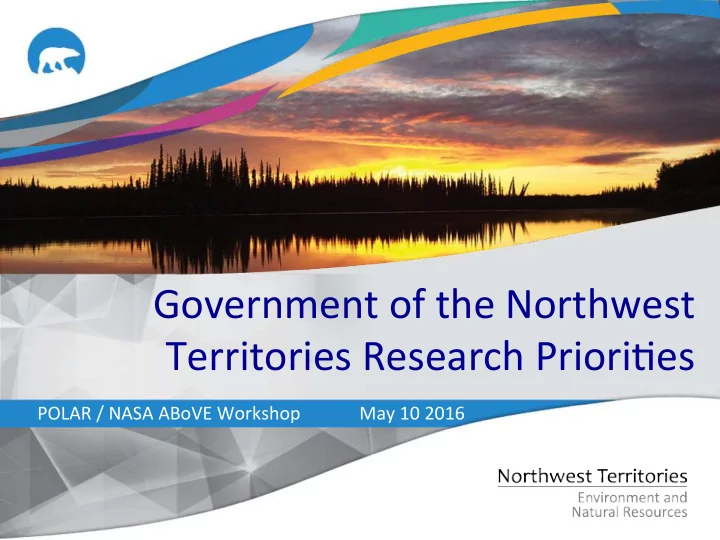

Government of the Northwest Territories Research Priori5es POLAR / NASA ABoVE Workshop May 10 2016
Developed in 2008 - 2009 GNWT focused initiative All departments engaged ECE, ENR co-leads
Climate Change as a Cross-Cutting Theme “The north is experiencing rapid and extensive changes often linked to climate change. This phenomenon has far reaching effects. These effects are altering northern ecosystems and all aspects of life in the NWT, from the man made to the natural and physical environment and from the health of the residents to NWT’s governance and socio-economic future”. GNWT Science Agenda
General Research Priorities 1. Geomorphic and other abiotic responses to climate change including slope stability, permafrost thaw, ground subsidence, surface and subsurface energy balances; 2.Terrestrial ecosystems changes, including forest composition change, fire behaviour and dynamics, conversion of one cover type to another type (e.g. forests to wetland or open tundra to shrub dominated taiga);
General Research Priorities 3. Implications of changing vegetation and water conditions for wildlife habitat, and for those communities whose traditional economies are dependent on harvest of potentially impacted species such as caribou; 4. Hydrological changes, including changes to runoff and storage processes, rates and timing of river flows;
General Research Priorities 5. Greenhouse gas flux changes and potential changes to air in quality in response to both changing climate and to induced changes in ecology and hydrology; 6. Feedbacks, linkages and interactions among the abiotic, ecological, hydrological, and geochemical processes and changes listed above;
General Research Priorities 7. The impact of all of these changes on Human and community health 8. The impact of all of these changes to cultural and heritage resources within the NWT 9. The development of applied research to support integrated mitigation and adaptation strategies related to these changes.
NWT Center for Geomatics 1. Access to NASA supercomputer cloud (beyond ParkSpace) for Burn Severity Mapping or potentially other NWT wide applications. 2. Real-time or near-real time access to fire mapping data (satellite imagery) 3. Real-time or near-real time ice/flooding data for NWT lakes, major rivers and Arctic ocean.
NWT Center for Geomatics • Assistance with mapping caribou population (access to fixed winged drones) • Access to ground-penetrating RADAR or other tools for assessing underground water • Access to coarse resolution imagery for NWT for pan-territorial mapping (NDVI, Forest Health, Caribou Mapping) • Access to improved digital elevation models (LIDAR) in communities and along critical infrastructure
NWT Center for Geomatics • Access to data and maps produced by NASA collaborators • Access to other products (reports, scripts) by NASA AboVE researchers • Scientific collaboration with NASA AboVE researchers • Access to climate change detection tools/ methods/technology • Improved mapping of Mackenzie mountains (higher resolution DEM)
NWT Center for Geomatics • L band and P band SAR for InSAR and PoliSAR monitoring activities (surficial displacement, permafrost monitoring, medium scale land classification, soil moisture) • Improved bathymetry of lakes, major rivers and ocean • Surficial Geology (glacial lacustrine, organic, glacial fluvial, granular, bedrock, peat, swamp, marsh) • Broad scale forestry classification data and tools
Cumulative Impacts Monitoring Program Mandate: To understand environmental trends and cumulative impacts related to land and water use Aboriginal Steering Committee Priority valued components: caribou, water and fish
Cumulative Impacts Monitoring Program • Broad spatial and temporal scale • regional analysis, long time scale • calculate and track landscape metrics • Standardized monitoring and reporting • Synthesis and analysis of existing data • Collection and analysis of baseline regional aquatic data and fish ecology in areas of development interest • Assessing cumulative impacts of human and natural disturbance • Assessing contaminants in fish
Forestry • Permafrost loss as it relates to forest type and ecoregion • Identification of underlying permafrost based on mapped attributes • How boreal caribou move across their habitat (when, where, and patterns) • Remotely sensed information that speaks to shrubification of the tundra
Forestry • Clear delineation of the historical NWT fire regime • Explore whether that fire regime seems to be changing as a result of climate change • What effects do extreme severity burns (particularly severe re-burns) have on the forest? Are they becoming more frequent? Can they cause long-term forest type changes? • What key factors contribute to fire refugia? What role do they play in post-fire forest recovery?
Recommend
More recommend